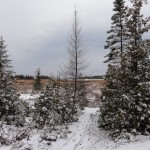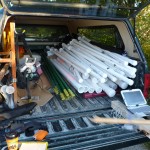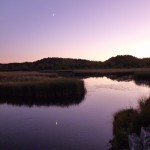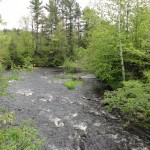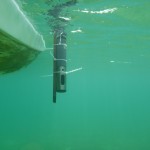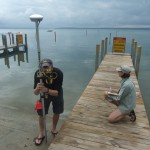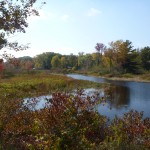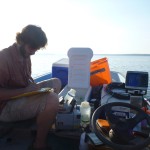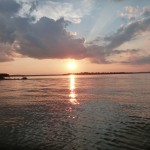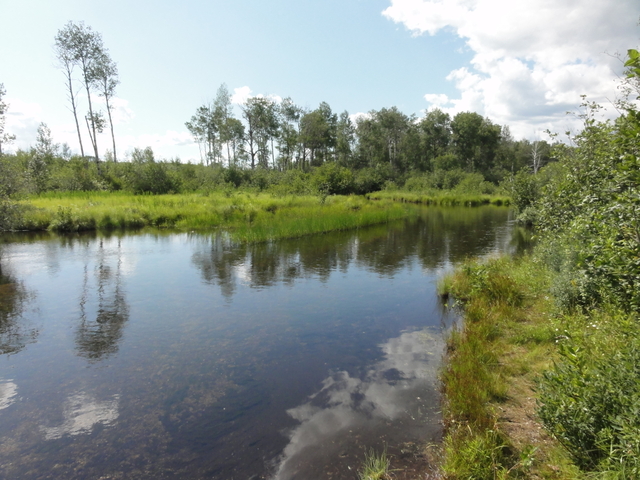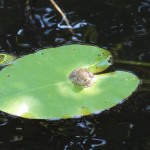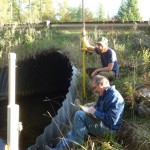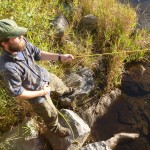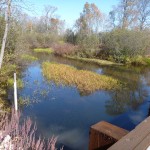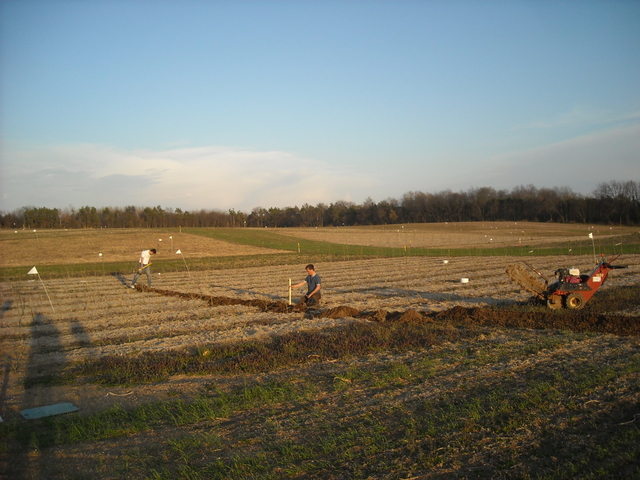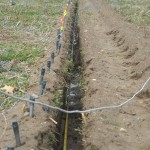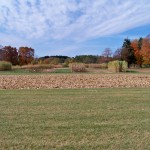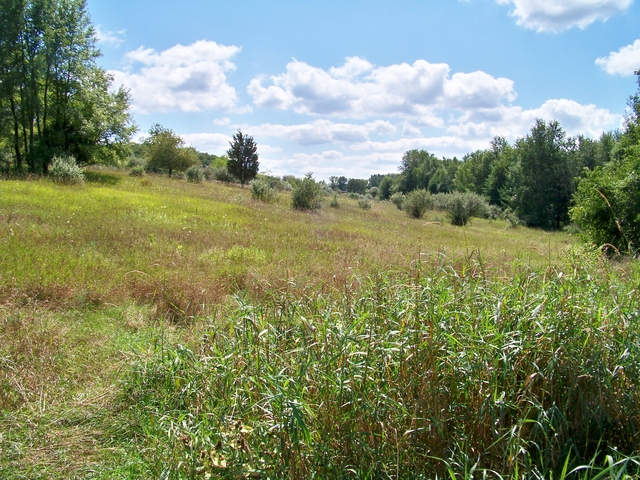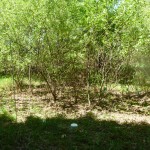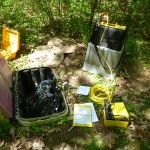- Understanding the hydrologic footprint of irrigated agricultural practices across the US, using model / data synthesis to understand paths toward sustainability.
- Fusing integrated hydrologic models with remote sensing estimates of water storage to develop nowcast and reanalysis of groundwater levels and streamflow across the Great Lakes Region.
- Quantifying the combined effects of changes in land use and climate on hydrology across a region experiencing rapid urbanization.
- Developing hydrology, energy, agriculture, and ecosystem models to better understand the footprint of solar arrays, which are being rapidly installed in agricultural lands.
Applicants must have expertise in programming (such as Python, MATLAB, R, or FORTRAN), and a strong publication record. Prior hydrologic modeling experience is also required. Familiarity with groundwater modeling, data science, and spatial data analysis are desired.
The initial positions are for one year (renewable based on performance). The MSU position will be a Postdoctoral Research Associate, with a long-term growth trajectory that could include promotion to Research Assistant Professor. At UTD, we are hiring at the Research Scientist level, however exceptional candidates with a strong record of successful grants may be hired as a Research Assistant Professor. These positions require writing peer-reviewed publications and research proposals to extend their position and help grow this interdisciplinary research team.
To apply, please submit: 1) an application letter detailing research interests and experiences, 2) a curriculum vitae, and 3) names and contact information for 3 references at:
- UT Dallas: Research Scientist (https://jobs.utdallas.edu/postings/24731), or Research Assistant Professor (https://jobs.utdallas.edu/hr/postings/24711)
- MSU (careers.msu.edu, posting #820561).
Please apply for only one of these positions. The search will remain open until suitable candidates are found, with a primary review of applications beginning on January 15, 2024. We will continue to review applicants after that date as well. For more information on the research conducted by this group, please visit hydrogeology.msu.edu. For other inquiries email Dr. Anthony Kendall at MSU (kendal30@msu.edu).
University of Texas at Dallas and Michigan State University are Equal Employment Opportunity/Affirmative Action employers. All qualified applicants will receive consideration for employment without regard to race, color, religion, sex, national origin, disability or protected veteran status or any other characteristic protected by law and University policies.
]]>**Michigan State University and the Kansas Geological Survey/University of Kansas**
Position 1: Groundwater Sustainability Pathways for the High Plains Aquifer
Seeking a postdoctoral scholar with a passion for groundwater sustainability and a penchant for thinking big to help envision a sustainable future for the High Plains Aquifer. The successful candidate will lead integrated land surface-groundwater modelling efforts to evaluate agricultural practices for the past and future of the High Plains Aquifer at multiple spatial and temporal scales. The postdoc will be based at the Kansas Geological Survey (University of Kansas) and have the opportunity to collaborate widely within multi-institution NSF INFEWS and USDA NIFA projects to produce high-impact research.
This position is funded for 2 years with the opportunity for extension pending performance and funding availability, and includes an annual research/travel budget to support professional development. The preferred start date is September 2019 with flexibility for the right candidate. For more information, please contact Sam Zipper (samzipper@ku.edu).
- Full job posting: http://employment.ku.edu/staff/13903BR
Position 2: Food, Energy, and Water in the Amazon and Mekong River Basins
Seeking a postdoctoral scholar ready to take on large-scale modeling challenges in data-limited regions. The Amazon and Mekong River Basins are undergoing rapid hydrologic, climatic, and land use changes, affecting two of the world’s most important hydrologic systems and the people and ecosystems dependent upon them. The postdoc will lead integrated surface- and groundwater-modelling efforts at both watershed and regional basin scales to better understand these vital systems, and how they are affected directly by dams and indirectly via land use and climate changes. The successful candidate will interact with two large, interdisciplinary project teams including multiple US institutions as well as international collaborators.
This position is funded for 2 years with the opportunity for extension pending performance and funding availability. The start date for this position can be as early as May 2019, with flexibility for the right candidate. For more information, please contact David Hyndman (hyndman@msu.edu). For more information on the research group, please visit hydrogeology.msu.edu.
Position 3: Water, Agriculture, and Nutrients in the Great Lakes Basin and California Central Valley
Seeking a postdoctoral scholar eager to quantify the role of agricultural practices in water and nutrient cycling in diverse agricultural landscapes spanning the US and Canadian Great Lakes Basin, as well as California’s Central Valley. The postdoc will lead efforts to develop integrated surface- and groundwater-models for these two regions, and to integrate new capabilities into those models. In particular we are looking to add explicit nutrient cycling and transport, informed by existing nutrient surface application and statistical transport models. We are working in those regions with a variety of collaborators in disciplines including remote sensing, ecology, agronomy, sociology, and economics to better understand the role that agriculture plays in water resources.
This position is funded for 2 years with the opportunity for extension pending performance and funding availability. The start date for this position can be as early as May 2019, with flexibility for the right candidate. For more information, please contact David Hyndman (hyndman@msu.edu). For more information on the research group, please visit hydrogeology.msu.edu.
Application Details and Required Qualifications
Common qualifications for all three positions include:
- expertise in groundwater and/or land surface modelling;
- ability to work both independently and collaboratively;
- strong communication skills as evidenced by peer-reviewed publications/conference presentations; and
- a water-related Ph.D. by the start date.
Experience with integrated models, GIS, and high-performance computing are considered a plus.
Unique qualifications by position include:
- Position 1: Coding experience (any of Python, R, FORTRAN, MATLAB, C, etc.) is strongly desired, experience working in irrigated agricultural landscapes is a plus
- Position 2: Coding experience (any of Python, R, FORTRAN, MATLAB, C, etc.) is required, knowledge of dam operations and management is a plus.
- Position 3: Coding experience (any of Python, R, FORTRAN, MATLAB, C, etc.) is required, knowledge of irrigated agricultural landscapes and snow hydrology is a plus.
To apply, send Sam Zipper (samzipper@ku.edu) an email with the subject line ‘Water Postdoc’ and the following materials as a single PDF file:
- Short (1-2 page) cover letter including which position(s) you would like to be considered for, why you are excited about them, and how you meet the qualifications.
- Full CV.
- Contact information for 3 references.
If you are interested in position 1, please also submit materials via the KU HR portal to http://employment.ku.edu/staff/13903BR – you can use the same cover letter for all 3 positions.
For full consideration, submit your application by April 15, but review of applications will continue until suitable candidates are found.
Michigan State University is an Equal Employment Opportunity/Affirmative Action employer. All qualified applicants will receive consideration for employment without regard to race, color, religion, sex, national origin, disability or protected veteran status or any other characteristic protected by law and University policy.
The University of Kansas prohibits discrimination on the basis of race, color, ethnicity, religion, sex, national origin, age, ancestry, disability, status as a veteran, sexual orientation, marital status, parental status, gender identity, gender expression and genetic information in the University’s programs and activities. The following person has been designated to handle inquiries regarding the non-discrimination policies: Executive Director of the Office of Institutional Opportunity and Access, IOA@ku.edu, 1246 W. Campus Road, Room 153A, Lawrence, KS, 66045, (785)864-6414, 711 TTY. http://policy.ku.edu/IOA/nondiscrimination
]]>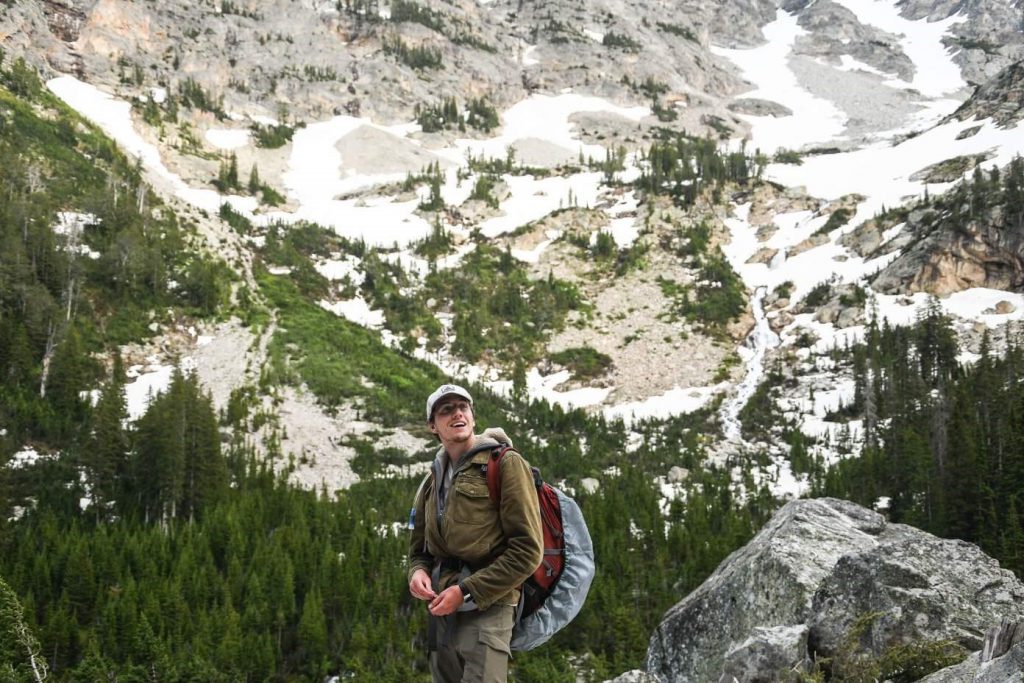 Research Interests
My interests in hydrology include groundwater processes, geology and its influence on both surface and groundwater, and subsequent impacts on water use. My involvement in research focuses on the properties of large scale aquifers in the central continental United States. Measuring the relationship between water use and energy expenditure, using analytical methods to evaluate total energy expenditure in a region, more specifically; Kansas. Water and energy are the one of the most important factors that determine agricultural yield and efficiency, impacting all steps of the agricultural process. I’m interested in quantifying this process and evaluating the current methods involved in increasing efficiency on a large scale.
]]>
Research Interests
My interests in hydrology include groundwater processes, geology and its influence on both surface and groundwater, and subsequent impacts on water use. My involvement in research focuses on the properties of large scale aquifers in the central continental United States. Measuring the relationship between water use and energy expenditure, using analytical methods to evaluate total energy expenditure in a region, more specifically; Kansas. Water and energy are the one of the most important factors that determine agricultural yield and efficiency, impacting all steps of the agricultural process. I’m interested in quantifying this process and evaluating the current methods involved in increasing efficiency on a large scale.
]]>Project Description
The Hydrogeology Lab at Michigan State University (hydrogeology.msu.edu) seeks a summer 2018 Research Experience for Undergraduates (REU) student for a project involving remote sensing of irrigation, cloud computing, and machine learning algorithms. Irrigation is rapidly expanding in parts of the Midwestern US where farmers have traditionally been reliant on rainfed agriculture. The causes of this expansion are many: shifts in crop prices, new/different crops being grown, more efficient technologies, government incentives for adoption, and the desire to reduce risks from changing rainfall patterns. The effects of this rapid expansion will reverberate throughout the hydrologic cycle, impacting water supplies, stream flows, land-atmosphere feedbacks, and water quality.
This project consists of three primary components: 1) working with remote sensing data from different platforms within cloud-based tools such as Google Earth Engine, 2) developing a robust training and validation dataset for machine learning algorithms, and 3) helping to improve those algorithms and incorporate advances from the fields of deep learning and artificial intelligence.
Despite the importance of irrigation to the hydrologic cycle in agricultural regions, very little data are available on its spatial and temporal extent. Our lab has been working to create Annual Maps of Irrigation (AIM) in the High Plains Aquifer region, as well as within southwestern Michigan. Within this REU project, we seek to expand those efforts and apply data from latest generation satellite platforms to supplement more traditionally-used Landsat data for irrigation mapping. The REU student on this project would build upon existing methodologies within Google Earth Engine (GEE) to integrate these latest products.
Additionally, the student will work to develop more robust validation and training data for classification algorithms, including working with the MSU Kellogg Biological Station’s Long-Term Ecological Research (KBS LTER) personnel to identify farms being actively irrigated during the 2018 growing season in order to obtain in-season irrigation data. Other sources of data might include aerial imagery that would be used to provide development validation data for the machine-learning algorithms running on the GEE platform.
Deep learning, which is commonly used to refer to an advanced class of artificial neural network algorithms, has made tremendous strides in the fields of language, image, and pattern recognition. These developments are beginning to be applied to remote sensing applications both commercially, and within academia. We hope to improve on the machine learning algorithms previously used in our irrigation classification work by incorporating deep learning for irrigation detection.
Fellowship Description
The ideal candidate will be motivated and interested in developing research skills. Previous experience working with GIS/remote sensing data, and some exposure to coding with scripting languages (e.g. R, Python, MATLAB), would be beneficial. Regardless of background, the candidate must be eager to learn new techniques and be tenacious in the face of early setbacks. We will provide ample opportunities for guided self-instruction, and a community focused on similar topics and methods. Our lab is large (20+ active researchers at all levels) and active, working on projects spanning the Great Lakes, US, and the globe.
The position will be for 11 weeks, from May 21 – August 3, 2018 and will be based at MSU in East Lansing MI. The student will need to find housing on campus or nearby campus. The student will work on average 40 hours a week and receive a stipend of $8000 to cover housing, living expenses, travel to MSU, and up to $500 in research supplies. The stipend will be paid in two payments, June 15 and July 15, 2018. Any travel for field research, presentations, or meeting off campus will be covered by the mentor’s lab.
The student will be responsible for 1) meeting all requirements of their mentor, 2) writing a blog post about their research for the KBS LTER website, 3) attending a professional development seminar at KBS on creating research posters on July 10, and 4) presenting a professional research poster at the KBS summer research symposium on August 1, 2018 at KBS.
This project is funded by the National Science Foundation’s Kellogg Biological Station Long-term Ecological Research (KBS LTER) program. Priority will be given to non-MSU students who may not have many research opportunities at their college or university and under-represented minority students. Please note, students must be a U.S. citizen to apply.
Apply by sending CV or resume, unofficial transcript, and a 1-page statement of interest describing why you are excited about this opportunity and what makes you an ideal candidate to Dr. Anthony Kendall at kendal30@msu.edu. Apply by March 1, 2018 for full consideration, applicants will be accepted through March 15th, 2018. Please email Dr. Kendall or Dr. David Hyndman (hyndman@msu.edu) with any questions.
]]>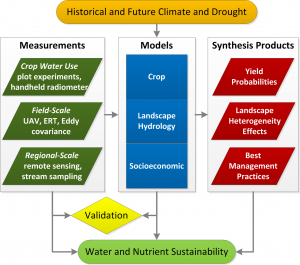 Recent extreme weather events provide insight into future challenges for agricultural systems across parts of the US due to increasing climate variability. Growing irrigation demand, significant declines in groundwater levels across the High Plains, and inefficient use of fertilizers leading to nitrate leaching, N2O emission, and pollution of surface water are threats to the U.S. corn-soybean-wheat systems and the industries and ecosystems that depend on them. We are: i) developing and improving management strategies for a water-, nutrient-, and climate-smart agriculture; ii) creating and disseminating decision-support tools to help farmers use “Big Data” (e.g., yield maps and UAV sensors) to adapt to climate variability and increase their resiliency; iii) evaluating the economics of smart agriculture technologies and practices.
Recent extreme weather events provide insight into future challenges for agricultural systems across parts of the US due to increasing climate variability. Growing irrigation demand, significant declines in groundwater levels across the High Plains, and inefficient use of fertilizers leading to nitrate leaching, N2O emission, and pollution of surface water are threats to the U.S. corn-soybean-wheat systems and the industries and ecosystems that depend on them. We are: i) developing and improving management strategies for a water-, nutrient-, and climate-smart agriculture; ii) creating and disseminating decision-support tools to help farmers use “Big Data” (e.g., yield maps and UAV sensors) to adapt to climate variability and increase their resiliency; iii) evaluating the economics of smart agriculture technologies and practices.
Our research integrates and experimentally tests a novel suite of biophysical and socioeconomic systems models to quantify interactions between climate, hydrology, and socioeconomic drivers of agricultural practices across the Upper Midwest and High Plains regions. Research, education, and extension activities in this project are providing accurate information for practical use by the general public, students, farmers, and decision makers to enable sustainable adaptation to and mitigation of temperature extremes, drought, and flooding. We are improving and deploying crop system models to evaluate a wide range of management options to optimize crop productivity while reducing water, N, and C footprints across spatial scales under a changing climate.
This work is being conducted in collaboration with Project Lead Investigator Bruno Basso.
Supported By

 Research Interests
Research Interests
Human activity is drastically altering the planet we live on in ways that we don’t fully understand. I am interested in studying the effects of hydropower installation, changes in land use, and climate change on the hydrologic regime of the Mekong River Basin. Study of this system will give crucial insight into how human activity affects one of the world’s largest rivers and how we could further manage this system to sustainably provide fresh water for the millions who depend on it.
CV
]]> I am a PhD candidate in the hydrogeology lab and a student intern with the U.S. Geological Survey’s Upper Midwest Water Science Center in Lansing, MI. My research focuses on better understating water quality and water resources in the Great Lakes though integration of field and remotely sensed data with process-based hydrologic models. My work is focused in two primary research areas: 1) investigating the landscape characteristics and hydrologic processes controlling stream chemistry, with a focus on anthropogenic nutrients and, 2) interactions between the Great Lakes and Michigan’s terrestrial groundwater. I am also interested in the fate and transport of emerging contaminants, and how surface water-groundwater interactions affect aquatic habitats in both streams and wetlands. In addition to my current work, I am actively interested in connecting hunter- and angler-based conservation organizations to academic research hydrology and water quality, to advance habitat protection and restoration efforts.
I am a PhD candidate in the hydrogeology lab and a student intern with the U.S. Geological Survey’s Upper Midwest Water Science Center in Lansing, MI. My research focuses on better understating water quality and water resources in the Great Lakes though integration of field and remotely sensed data with process-based hydrologic models. My work is focused in two primary research areas: 1) investigating the landscape characteristics and hydrologic processes controlling stream chemistry, with a focus on anthropogenic nutrients and, 2) interactions between the Great Lakes and Michigan’s terrestrial groundwater. I am also interested in the fate and transport of emerging contaminants, and how surface water-groundwater interactions affect aquatic habitats in both streams and wetlands. In addition to my current work, I am actively interested in connecting hunter- and angler-based conservation organizations to academic research hydrology and water quality, to advance habitat protection and restoration efforts.
I received my Bachelors in biology form Albion College, and my Masters in Earth and Environmental Science from MSU in 2020. Between my Bachelors and Masters degrees, I worked at Los Alamos National Laboratory in the Earth and Environmental Sciences Division. My previous research has focused on the fate, transport, and remediation of organic contaminants in groundwater aquifers, nutrient biogeochemistry in groundwater discharge areas with stream channels, and the effects of land cover and climate change on water resources in the Brazilian Amazon. In addition to my academic interest in water, I’m an avid outdoorsman, and an active member of Backcountry Hunters and Anglers, Ducks Unlimited, and Trout Unlimited.
]]>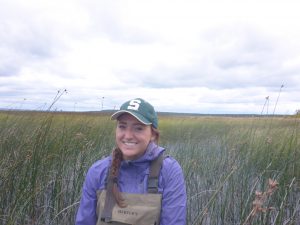 Research Interests
Research Interests
My research interests include determining how human activity can affect water quality and play a role in watershed ecology. More specifically, I am investigating how landscape nutrient loading relates to coastal wetland invasion within the Great Lakes.
CV
]]>We are hiring multiple postdoctoral associates to lead data analysis and modeling efforts for ongoing and new watershed hydrology projects at the Hydrogeology Lab at Michigan State University. The lab focuses on predicting the responses of hydrologic systems to changes in climate, landscape, and land management. In particular, we seek to develop and improve the tools to make these predictions, and to apply them to better understand how to improve sustainability of land use practices and adapt to future changes. Our highly interdisciplinary research is conducted in collaboration with researchers across MSU and universities nationwide.
The successful candidates will apply and develop cutting-edge methods in: real-time simulation, big-data compilation, processing, and analysis; modeling data-limited regions; improving landscape hydrologic models; and coupled process models of agriculture, ecosystems, and climate with hydrologic models. Applicants must have expertise in programming in a language such as Python, MATLAB, R, or FORTRAN. Prior hydrologic modeling experience is also required. Familiarity with GIS and spatial data analysis is desired, and big-data experience is a plus.
Postdoctoral researchers will be actively mentored toward their professional goals. We will work with the successful candidate to develop individualized mentoring plans focused on technical skills training, professional networking, establishing interdisciplinary collaborations, mentoring students, and eventual job placement.
We will begin reviewing applications on June 15, 2017, and the search will remain open until suitable candidates are found. Start date is flexible, with 2017 being preferred. For more information on the research group, please visit hydrogeology.msu.edu.
To apply, please send an application letter detailing research interest and experiences, curriculum vitae, and names of 3 references (with telephone numbers and email addresses) to:
Please direct questions about the positions to Dr. David Hyndman (hyndman@msu.edu) and cc all correspondence to geosci@msu.edu.
Michigan State University is an Equal Employment Opportunity/Affirmative Action employer. All qualified applicants will receive consideration for employment without regard to race, color, religion, sex, national origin, disability or protected veteran status or any other characteristic protected by law and University policy.
]]> Personal History
Personal History
Growing up near a beautiful coast in China, I gained my love for water and rocks. Studying in major about soil and water presented a good basic for my research. I have a strong desire to learn more about nature and help to improve the environment. Satellite-based Estimates of Groundwater Depletion in India by Matthew Rodell published in Nature in 2009 attracted my attention on ground water, which shown in the article, changed more considerably than surface water in India. It is significantly important and challenging, so I made my decision to focus on groundwater more than surface water in my following career.
Research Interests
I am interested in exploring groundwater and how to use groundwater best for human. I’m currently focused on coupling human and natural systems and improve water resources sustainability in metropolis.
Education
- M.S. Michigan State University Environmental Geosciences 2013-Present
- M.S. Beijing Normal University, China Hydrology and Water Resources 2010-2013
- B.S. Beijing Forestry University, China Soil and Water Conservation 2006-2010
Complete CV
]]> Research Interests
Research Interests
I am interested in studying the High Plains Aquifer through the CLASS project. Some of the aspects that intrigue me include the effect of climate change as well as the economic impact of the aquifer. I will use various models to study the aquifer’s changes throughout time such as rate of depletion and recharge.
Education
- B.S. Atmospheric Science, Purdue University, 2013
Certificate, Learning Beyond the Classroom, Purdue University, 2013
 Lin Liu is a masters student in the Department of Geological Sciences. Before she came to Michigan State University, she had pursued a Bachelor degree in Environmental Science from Sichuan University (P.R China). She studied at State University of New York College of Environmental Science and Forestry for a one-year exchange program and participated in the “MELNHE” project. During her course of education, she identified her professional goal as understanding biophysical processes and integrating social aspects with the natural system. Currently, she is using modeling technique to understand swichgrass cultivation impact on Michigan’s water resources for her thesis. Click here to view her resume.
Lin Liu is a masters student in the Department of Geological Sciences. Before she came to Michigan State University, she had pursued a Bachelor degree in Environmental Science from Sichuan University (P.R China). She studied at State University of New York College of Environmental Science and Forestry for a one-year exchange program and participated in the “MELNHE” project. During her course of education, she identified her professional goal as understanding biophysical processes and integrating social aspects with the natural system. Currently, she is using modeling technique to understand swichgrass cultivation impact on Michigan’s water resources for her thesis. Click here to view her resume.
Complete CV
Download my complete CV.
]]> I grew up in Elk, Rapids, a small town in Northern, Michigan located on Grand Traverse Bay. Growing up so close to Lake Michigan and spend a lot of my time. This experience made me develop a strong appreciation for environmental quality and I wanted to apply my interest in the environment to my career. Now I am a senior in my undergraduate studies at Michigan State University. I plan to graduate in the spring of 2014 with my degree in Environmental Engineering with a concentration on water resources. I have been working in the hydrogeology lab since January 2013.
I grew up in Elk, Rapids, a small town in Northern, Michigan located on Grand Traverse Bay. Growing up so close to Lake Michigan and spend a lot of my time. This experience made me develop a strong appreciation for environmental quality and I wanted to apply my interest in the environment to my career. Now I am a senior in my undergraduate studies at Michigan State University. I plan to graduate in the spring of 2014 with my degree in Environmental Engineering with a concentration on water resources. I have been working in the hydrogeology lab since January 2013.
Download my complete resume.
]]> Henry Whitenack is a junior from Troy, MI, pursuing an Environmental Geosciences major with a Specialization in Environmental Studies. Henry found interest in nature at a young age, going on camping trips with his family, picking up rocks wherever he went. His Environmental Studies class in High School strongly influenced him in pursuing his major. He plans on going into a Master’s program after completing undergraduate studies at MSU. Along with geology, Henry enjoys the outdoors and is an avid US National Men’s Soccer Team fan.
]]>
Henry Whitenack is a junior from Troy, MI, pursuing an Environmental Geosciences major with a Specialization in Environmental Studies. Henry found interest in nature at a young age, going on camping trips with his family, picking up rocks wherever he went. His Environmental Studies class in High School strongly influenced him in pursuing his major. He plans on going into a Master’s program after completing undergraduate studies at MSU. Along with geology, Henry enjoys the outdoors and is an avid US National Men’s Soccer Team fan.
]]> Coupled Human-Water Systems
Coupled Human-Water SystemsMy research integrates the biophysical, socioeconomic, and political components of human water use to inform sustainable water management. I use satellite remote sensing and economic data to drive physical models of human-water systems, including agricultural and urban water uses. These systems models are then used to understand human water use, governance, and the associated impacts on water resources.
Deines Curriculum Vitae – September 2017
Education
- Ph.D., Michigan State University, May 2013 – present
Environmental Geosciences - M.S., Biological Sciences, University of Notre Dame, 2009
Thesis: Conservation management under climate change: on tropical drought resistance, non-native species response to increasing disturbance, and assisted migration
Advisor: Jessica J. Hellmann - B.S., Ecology and Evolutionary Biology, Saint Louis University, 2006
Minor: Anthropology
]]>
This project is funded by NASA, in collaboration with the University of Michigan and Michigan Tech Research Institute.
]]>We would like to acknowledge the USGS for funding this research.
]]>We would like to thank the Michigan State Department of Natural Resources and the Higgins Lake Foundation for their support of our work in the Higgins Lake and Cut River system.
]]>
]]>

The MSU Hydrogeology Lab has been conducting research in the Jordan River Watershed since 2006. The objective has been to understand the causes and possible solutions to sand accumulation on what had been considered previously to be a primarily gravel-bed stream. The sand is believed to be negatively impacting the fishery of the Jordan River, possibly reducing populations of brown and brook trout in one of Lower Michigan’s premier cold water streams. The work has been funded by the Friends of the Jordan River.
During the course of our research, the Lab has installed a network of stream gauging stations to continuously monitor stream flow and temperature, conducted extensive channel surveys for sediment and flow modeling, surveyed the stream channel with a variety of sophisticated instruments including an Acoustic Doppler Current Profiler (ADCP), survey-grade Global Positioning System (GPS), and both floating and land-based Ground Penetrating Radar (GPR).
Research Products
Presentations to FoJ and Regional Stakeholders
Martin et al. 2010
Jasinski et al. 2012
Photo Albums
Below are a selection from several thousand photographs of the Jordan River and its watershed taken by MSU researchers and students during the course of this project. Stream bank and sediment photos were taken during three float trips down the Jordan River during October 2009, November 2010, and July 2011. Photos of beaver activity are from 2010 and 2011. Others are indicated in their albums below.
The maps below show photos at their proper locations using GPS coordinates. For best viewing, click the magnifying glass and view full-screen. Also, there are in some cases many photos at the same location, to view all of them, click the “Earth” button. This may require that you install the Google Earth plug-in (a link will be provided).
Stream Bank Photos
[xmlgm ngg_gallery=4]
Stream Sediment Photos
[xmlgm ngg_gallery=2]
]]> ]]>
]]>Projects:
]]>We would like to to thank the National Science Foundation for funding this research.
Projects:
]]>- BS 2008, Istanbul Technical University, Geophysical Engineer
Recent Abstracts
- van Dam R.L., Diker K., Bhardwaj A.K., Hamilton S.K., (2009),
Spatial variability of near-surface soil moisture for bioenergy crops, at the Great Lakes Bioenergy Research Center, AGU Fall Meeting, San Francisco - Diker K., van Dam R.L., Bhardwaj A.K., Hamilton S.K., (2010), Electrical resistivity measurements at GLBRC: instrumentation, data collection, and processing, GLBRC Thrust 4 (Sustainability) Retreat, Hickory Corners
- Bhardwaj A.K., Hamilton S.K., van Dam R.L., Diker K., Basso B., (2010)
Root zone soil water dynamics and its effects on above ground biomass in cellulosic and grain based bioenergy crops of Midwest USA, AGU Fall Meeting, San Francisco
 Research Interests
Research InterestsMy current interests are in applied geophysics and hydrogeophysics and their environmental applications. My master’s thesis research focuses on using electrical resistivity tomography to study the transient nature of natural free convection in a sabkha in the United Arab Emirates.
Education
BS 2009, Western Michigan University, Geology
Recent Abstracts
Eustice, BP, DW Hyndman, RL Van Dam, WW Wood, (2010), Modeling and Electrical Imaging of Natural Free Convection Induced by Saline Recharge in a Coastal Sabkha, AGU Fall Meeting, San Francisco
Dr. Kendall has begun an appointment as a postdoctoral researcher in the Hydrogeology Lab.
]]>
We have developed a novel hydrologic process model called the Integrated Landscape Hydrology Model (ILHM), which is a framework of existing and novel codes to simulate the entire hydrologic cycle at large watershed scales. ILHM is capable of modeling all the major surface and near-surface hydrologic processes including evapotranspiration, groundwater recharge, and stream discharge. In the first published application of the model, the ILHM-modeled stream flows compared favorably with measured data with a minimum of parameter calibration. It was tested for a small watershed (~130 square kilometers) in Michigan, and is currently being applied to much larger domains.
The figure on the left shows average simulated groundwater recharge over a 27 year period (1980-2006) for the Muskegon River Watershed in central lower Michigan. Calculated groundwater recharge values vary as much as 50% across the watershed within similar land use classes. Recharge also varies significantly between land use types.
The primary ILHM code is written in the MATLAB computing environment with some routines coded in C and FORTRAN. GIS inputs in a variety of formats can be used. Time-series inputs and parameter values are stored in MySQL, and model outputs are written to disk in HDF5 format.
Understanding dynamic watershed processes requires high spatial and temporal resolution simulations coupled to extensive databases of groundwater levels and stream flows. Our groundwater flow simulations are being integrated into a suite of tools to better understand the influence of land use and climate changes on water flows, nutrient fluxes to streams, and the health of aquatic ecosystems.
Related Publications:
- Wiley, M., B. Pijanowski, R. Stevenson, P. Seelbach, P. Richards, C. Riseng, D. Hyndman, and J. Koches, (2008), Integrated Modeling of the Muskegon River: Ecological Risk Assessment in a Great Lakes Watershed. In “Wetland and Water Resource Modeling and Assessment: A Watershed Perspective”, CRC Press.
- Stevenson, R. J., M. J. Wiley, S. H. Gage, V. L. Lougheed, C. M. Riseng, P. Bonnell, T. M. Burton, R. A. Hough, D. W. Hyndman, J. K. Koches, D. T. Long, B. C. Pijanowski, J. Qi, A. D. Steinman, and D. G. Uzarski, (2008), Watershed Science: Essential, Complex, Multidisciplinary and Collaborative. In “Wetland and Water Resource Modeling and Assessment: A Watershed Perspective”, CRC Press.
- Hyndman, DW, AD Kendall, and NRH Welty, (2007), Evaluating Temporal and Spatial Variations in Recharge and Streamflow Using the Integrated Landscape Hydrology Model (ILHM), AGU Monograph, Data Integration in Subsurface Hydrology
- Kendall, AD, and DW Hyndman, (2007), Examining Watershed Processes Using Spectral Analysis of Hydrologic Time Series, AGU Monograph, Data Integration in Subsurface Hydrology
- Jayawickreme, DH, and DW Hyndman, (2007), Evaluating the Influence of Land Cover on Seasonal Water Budgets Using Next Generation Radar (NEXRAD) Rainfall and Streamflow Data, Water Resources Research, 43, W02408
Related Conference Abstracts:
- Kendall, AD, and DW Hyndman, (2007), Simulating Fluxes Through Large Watersheds Using Remotely Sensed and Ground Based Datasets With the Integrated Landscape Hydrology Model ILHM, Geological Society of America, Abstracts with Programs
- Kendall, A, JA Bernstein, and DW Hyndman, (2007), Improving Regional Groundwater Recharge Models With A Network Of High-Resolution Temperature Recording Buttons, Geological Society of America, Abstracts with Programs
- Hyndman, DW, AD Kendall, (2006), The Integrated Landscape Hydrology Model (ILHM), a Fully-Distributed Approach to Simulate Regional Watershed Hydrologic Processes, H11A-1234, Eos Trans AGU
- Kendall, AD, DW Hyndman, (2006), Predicting Streamflow, Groundwater Recharge, and Evapotranspiration at the Regional Scale with the Integrated Landscape Hydrology Model (ILHM), H31H-06, Eos Trans AGU
 Related Publications:
]]>
Related Publications:
]]> Solute transport through heterogeneous environments is often poorly understood because of inadequate definition of aquifer stresses and boundary conditions. One approach to address these concerns is to transport a large, minimally disturbed, highly heterogeneous aquifer mesocosm to a controlled laboratory setting. This approach will bridge the gap between small-scale laboratory studies and large-scale field studies.
]]>
Solute transport through heterogeneous environments is often poorly understood because of inadequate definition of aquifer stresses and boundary conditions. One approach to address these concerns is to transport a large, minimally disturbed, highly heterogeneous aquifer mesocosm to a controlled laboratory setting. This approach will bridge the gap between small-scale laboratory studies and large-scale field studies.
]]> Ground water chemistry is reflective of time-weighted averages of anthropogenic inputs originating from spatial and temporal patterns of land use. We developed an approach to examine potential relationships between land use-derived solutes and baseflow surface water quality using regional ground water and solute transport models linked to GIS. Our first test of this approach estimated chloride concentrations in surface water due to road salt transport through ground water in Michigan’s Grand Traverse Bay watershed.
Ground water chemistry is reflective of time-weighted averages of anthropogenic inputs originating from spatial and temporal patterns of land use. We developed an approach to examine potential relationships between land use-derived solutes and baseflow surface water quality using regional ground water and solute transport models linked to GIS. Our first test of this approach estimated chloride concentrations in surface water due to road salt transport through ground water in Michigan’s Grand Traverse Bay watershed.
Further development of watershed-scale groundwater flow and transport models has been undertaken to examine the impacts of various land uses on nitrate concentrations. In Michigan, streams are predominantly groundwater-fed for much of the year. Therefore, understanding groundwater nitrate concentrations and fluxes is vital to understanding stream water quality. The figure on the left shows a preliminary simulation of total N concentrations in Cedar Creek, a small subwatershed of the Muskegon River in central lower Michigan.
Related Publications:
Wood W.W. and Sanford W.E., 2007, Atmospheric bromine flux from the coastal Abu Dhabi sabkhat: A ground-water mass-balance investigation. Geophysical Research Letters, 34(14).
Tyler S.W., Munoz J.F., and Wood W.W., 2006, The response of playa and sabkha hydraulics and mineralogy to climate forcing. Ground Water, 44(3), 329-338.
Wood W.W., Sanford W.E., and Frape S., 2005, Chemical openness and potential for misinterpretation of the solute environment of coastal sabkhat. Chemical Geology, 215(1-4), 361-372.
Related Conference Abstracts:
]]> Ground-water contamination with volatile organic compounds is a significant national and international problem. Waters containing these contaminants are typically pumped from contaminated aquifers and treated by air stripping or sorption onto activated carbon. These methods are costly, do not destroy the contaminants, may require pumping and disposal of large water volumes, and do not effectively remove contaminants sorbed to the aquifer material.Accordingly, there has been a great deal of interest in alternative treatment strategies, such as enhanced in-situ remediation. Our research group in collaboration with the Departments of Civil and Environmental Engineering and the Center for Microbial Ecology designed and installed a cost-effective biocurtain that is currently being used to remove carbon tetrachloride from an aquifer in Schoolcraft, Michigan. Novel aspects of the design are the use of closely-spaced wells to recirculate solutes through a biocurtain, well screens spanning the vertical extent of contamination, and a semi-passive mode of operation, with only six hours of low-level pumping per week.
Ground-water contamination with volatile organic compounds is a significant national and international problem. Waters containing these contaminants are typically pumped from contaminated aquifers and treated by air stripping or sorption onto activated carbon. These methods are costly, do not destroy the contaminants, may require pumping and disposal of large water volumes, and do not effectively remove contaminants sorbed to the aquifer material.Accordingly, there has been a great deal of interest in alternative treatment strategies, such as enhanced in-situ remediation. Our research group in collaboration with the Departments of Civil and Environmental Engineering and the Center for Microbial Ecology designed and installed a cost-effective biocurtain that is currently being used to remove carbon tetrachloride from an aquifer in Schoolcraft, Michigan. Novel aspects of the design are the use of closely-spaced wells to recirculate solutes through a biocurtain, well screens spanning the vertical extent of contamination, and a semi-passive mode of operation, with only six hours of low-level pumping per week.
Related Publications:
]]> A fundamental issue in aquifer biogeochemistry is the means by which solute transport geochemical processes, and microbiological activity combine to produce spatial and temporal variations in redox zonation. Our Hydrogeology and Hydrogeochemistry groups are examining the temporal variability of TEAP conditions in shallow groundwater contaminated with waste fuel and chlorinated solvents.
A fundamental issue in aquifer biogeochemistry is the means by which solute transport geochemical processes, and microbiological activity combine to produce spatial and temporal variations in redox zonation. Our Hydrogeology and Hydrogeochemistry groups are examining the temporal variability of TEAP conditions in shallow groundwater contaminated with waste fuel and chlorinated solvents.
Related Publications:
]]> New methods of estimating aquifer properties are needed to improve our understanding of the factors that influence the transport and fate of groundwater contaminants, and to better design remediation systems. Geophysical methods have long been applied to characterize oil reservoirs, while their application to characterize aquifers is much more recent. Our research group is developing a novel set of approaches that combine diverse hydrologic and geophysical data sources to estimate flow and transport properties with the highest resolution possible.
New methods of estimating aquifer properties are needed to improve our understanding of the factors that influence the transport and fate of groundwater contaminants, and to better design remediation systems. Geophysical methods have long been applied to characterize oil reservoirs, while their application to characterize aquifers is much more recent. Our research group is developing a novel set of approaches that combine diverse hydrologic and geophysical data sources to estimate flow and transport properties with the highest resolution possible.
Related Publications:
Bridge, JS and DW Hyndman, (2004), Preface: Aquifer Characterization, SEPM Special
]]> Personal History
Personal History
At the age of 15, I watched the Cuyahoga River burn from my back yard. From that point on, I knew I wanted to be in the environmental field. After thirty years of professional experience and management in the environmental field, I elected to return to school and work on my doctorate so that I could bring real world experiences into the classroom.
Research Interests
As a consultant, I’ve had the opportunity to observe the impact of contaminated groundwater on various surface water bodies. In many cases, the impacts were not as anticipated. Surface water quality should be directly linked to both the sources of contaminants and the water body’s capacity to interact with and adjust to changing environmental (hydrologic and geochemical) conditions. Unfortunately, the dynamics of surface and ground-water interactions are very complex and not well understood.
My research focuses on local-scale hydrology at a point bar system located on a tributary of the Muskegon River, where I am examining the relationships among groundwater, surface water, porosity, soil moisture, and hydraulic conductivity. To determine these local relationships, I developed a network of 20 monitoring wells, 2 stream gauging stations, four soil moisture stations and a weather station to collect the appropriate hydrologic data for my dissertation.
Education
M.Engineer, Geologic Engineering, Colorado School of Mines, Golden, Colorado, 1983.
B.S., Geology, University of Cincinnati, Cincinnati, Ohio, 1975.
Publications
Bove, J. and L. M Cooper, 1990. “An Introduction to Geosynthetics: Fundamentals, Applications, and Design,” Short Course, 33rd Annual Meeting, Association of Engineering Geologists, Pittsburgh, PA.
Cooper, L. M. and R. Hosfeld, 1986. “Investigation and Remediation of a Pond Contaminated by Diesel Fuel,” 7th National Conference on Management of Uncontrolled Hazardous Waste Sites, HMCRI, Washington, D.C.
Cooke, S. D.; Cooper, L. M and C. W Byrer, 1984. “A Site Characterization and Environmental Monitoring Approach for UCG Research and Development in Bituminous Coals,” 10th Annual UCG Symposium, DOE.
Howard, J. F., Komar, C. A. and L. M. Cooper, Editors, 1984. “Workshop on Remote Sensing/ Lineament Applications for Energy Extraction,” U.S. Department of Energy DOE/METC/84-9, Morgantown, WV
Cooper, L. M., 1983, “Applications of Geophysics to Hydrogeologic Studies in Routt and Jackson Counties, Colorado,” Colorado School of Mines, Golden, Colorado, prepared as an open-file report for the U.S. Geological Survey, Lakewood, Colorado. (Master’s Thesis)
Abstracts
Cooper, L. M., 2007, “Remediation of a “Free-Product” Contaminant Plume at a Leaking UST Site using In-Situ Bio-Remediation and SVE,” American Institute of Professional Geologists, Lansing, Michigan.
Cooper, L. M., 2004. “Dancing with Brownfields: The Zephyr Oil Story,” Association of Engineering Geologists Annual Meeting, Dearborn, Michigan.
Cooper, L. M., 1998. “Remediation of a Chlorinated Solvent Plume,” Association of Engineering Geologists Annual Meeting, Seattle, Washington.
Cooper, L. M., 1996. “Quality Control and Quality Assurance in Environmental Consulting,” Association of Engineering Geologists Annual Meeting, New Brunswick, New Jersey.
Complete CV
]]>
I first started my career as geologist knowing that I wanted to major in either environmental geology or hydrogeology in my eighth grade year of middle school at my home town, Spring Lake, MI. I went on through high school never changing what I wanted to be all the way through high school and college by which I eventually graduated from Central Michigan University with a B.S. with a major in Environmental Geology and another major in Environmental Science.
In the fall of 2005 I applied to Michigan State University after being in contact with Dr. Hyndman (my current advisor). I was impressed on how close the research group here was and how closely everyone worked together. There seemed to be an abundance of research topics that I could have worked with ranging from hydrology to near surface geophysics. Two years later I am completing my thesis on Land use effects on sediment and nutrient transport. I have also had the chance to present my research from other projects I have done while at MSU at the American Geophysical Union (held in San Francisco) for three consecutive years and once at GSA in Salt Lake City.
My experience while working in this lab as a hydrologist and Environmental Geophysicist has befitted my career. The skill sets, knowledge, and working synergy that I have come to enjoy have been my number one reason I would recommend this lab to anyone. The unique combinations of modeling capabilities, hydrology related field work, near-surface geophysical methods, and the critical thinking skills that one can develop as a Master’s or PhD will provide a valuable skill set to any company, research group, or institution/agency.
I am currently interviewing for jobs out in the Seattle, Atlanta, and Denver areas. After graduating with my M.S., I hope to work a few years in the consulting industry and then go back for my PhD.
]]> Research Interests
Research Interests
My research has focused on regional-scale landscape hydrology, examining the terrestrial hydrologic cycle and its relationship to climate, vegetation and biogeochemical cycles. I c0-developed the Landscape Hydrology Model (LHM), an integrated modeling tool to study large-scale, fine-resolution hydrologic processes using modest computational tools. Partly due to the challenge of providing fine-resolution inputs at regional scales, and because of the importance of the questions at those scales I have become involved in all aspects of “big data” discovery, processing, and analysis. This includes using machine learning algorithms to yield insights into environmental phenomena and to better prepare inputs for process-based models. I am also (as my photo suggests) actively involved in field data collection, and view this as a critical and foundational aspect of hydrologic sciences.
I have spent most of my research career as part of large, interdisciplinary research teams, working at all levels from undergraduate to Co-PI. Along the way I developed a deep appreciation of the value of interdisciplinary research, and a recognition that most of society’s great questions lie not within the walls of a discipline, but at their intersections. In the last few years I and other members of the Hydrogeology Lab have built strong collaborations with climate scientists, ecologists, agronomists, socio-behavioral scientists, economists, and engineers. These collaborative relationships are driving forward the next generation of research here at MSU and around the world.
Education
- PhD 2009, Michigan State University, Environmental Geosciences
Thesis: Predicting the Impacts of Land Use and Climate Change on Regional-Scale Hydrologic Fluxes
Advisor: Dr. David W. Hyndman - BS 2004, Michigan State University, Mechanical Engineering
- BS 2004, Michigan State University, Astronomy/Astrophysics
Recent Publications
- Deines J.M., Kendall A.D., Hyndman D.W. (2017), Annual irrigation dynamics in the US Northern High Plains derived from Landsat satellite data, Geophysical Research Letters. Early View Available, DOI: 10.1002/2017GL074071
- Hyndman, D.W., T.Xu, J.M. Deines, G. Cao, R. Nagelkirk, A. Vina, W. McConnell, B. Basso, A.D. Kendall, S. Li, L. Luo, F. Lupi, J.A. Winkler, W. Yang, C. Zheng, and J. Liu, (2017), Quantifying changes in water use and groundwater availability in a megacity using novel integrated systems modeling. Geophysical Research Letters. Early View Available, DOI: 10.1002/2017GL074429
- Cotterman, K.A., Kendall, A.D., Basso, B., and D.W. Hyndman, (2017), Groundwater Depletion and Climate Change: Crop Production Declines over the Ogallala Aquifer, Climatic Change: accepted, DOI: 10.1007/s10584-017-1947-7
- Luscz, E.C., Kendall, A.D., and D.W. Hyndman, (2017), A spatially explicit statistical model to quantify nutrient sources, pathways, and delivery at the regional scale, Biogeochemistry: 133(1), 37-57, DOI: 10.1007/s10533-017-0305-1
- Martin, S.L., Hayes, D.B., Kendall, A.D., and D.W. Hyndman, (2017), The land-use legacy effect: Towards a mechanistic understanding of time-lagged water quality responses to land use/cover, Science of the Total Environment 579: 1794-1803, DOI: 10.1016/j.scitotenv.2016.11.158
